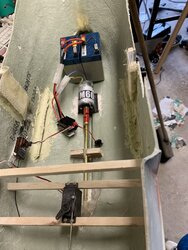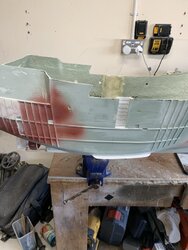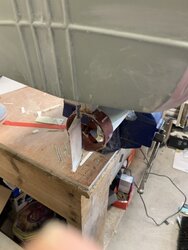As promised, some photos and sketches...
Firstly, I now have both halves of the main chassis rails. I've marked out on the top surface where the edge of the rails are in real life and where the axle lines are located. I've done the same on the underside, so it's easier to know where to put things later.
Plus I've been sketching out the front suspension. It's a fairly standard racing car layout on the front - stub axle, brake disk, outboard shock, double wishbone, but the problem I have is that I don't have clear enough photos to get the exact design of the wishbones. Lower wishbone is far less of a problem than the top, but some guesstimation will be required.
The second sketch is actually 1:5 rather than the 1:10 that I'm working in. Basically it's easier to draw and measure. Spoke to the friend who is giving me techy help, and it turns out I've got the dimensions (especially for the damper length) bang on. Kind of rather pleased with that.

Next, my diddy little brake discs, with a 2p piece for scale. They've since been sanded and base coated etc, and are ready to be painted. But I won't be doing that step just yet. I'm using a mix of titanium white and payne's grey to base coat parts, btw. Thanks for the advice on that
@Andy in Germany - it really makes missed bits and flaws stand out.

Been working on the stub axles these last few days. Made, built and discarded a prototype, as it was way over-engineered. The card I'm using sets really solid with the glue, so I can make the component much more true-to-type. Even so, the templates went through several iterations before I ended up with something I'm happy with. I don't dare make it spindlier, because it's a major structural component. I think I've got a good compromise between looking right and being sturdy enough to do the job. Of course, it will look much better when it's sanded and painted up.
So, right hand front stub axle, plus the parts to make the left hand one, bar a wooden peg and a fine upholstery pin. I've drilled the holes to take the steering arm and the lower wishbone, but not the one for the upper wishbone. I'm leaving that until I've got a design for the wishbone that I'm happy with, and that I can actually make.
Rear view of stub axle
And finally, the assembly of wheel, brake disc and stub axle. And, mirabile, after all that faffing, they all fit together! (edited to point out that they're not glued together yet - was just checking the fit!)
OK, some of the bits still need a little finishing and TLC, but right now, I don't have enough good daylight to paint / sand etc all the very fiddly bits. So I'm concentrating on the design work, making parts and making sure stuff fits together as it should. The rest can wait for now.



 Might be a while before I finish it, but I hope it'll be worth the wait.
Might be a while before I finish it, but I hope it'll be worth the wait.









